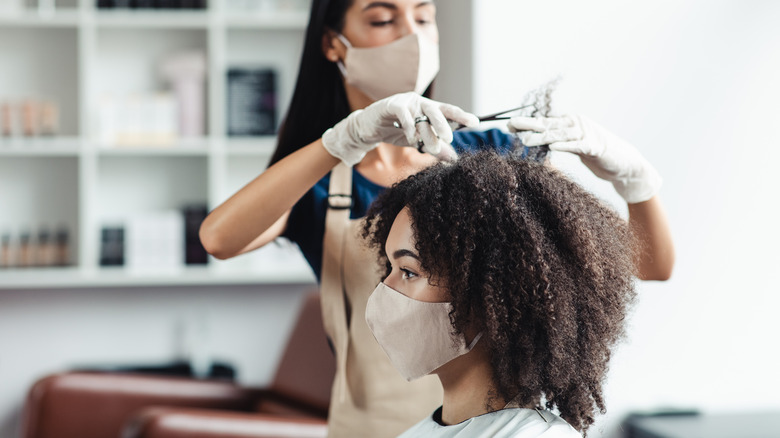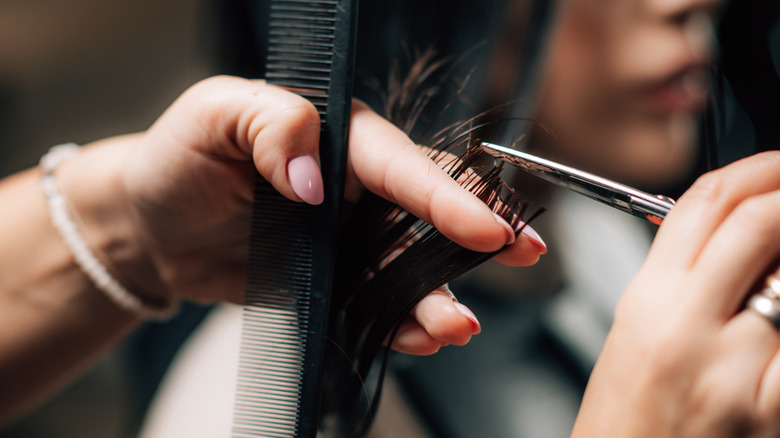Does Trimming Your Hair Actually Make It Grow Faster? Here's What A Hairstylist Has To Say - Exclusive
Grandparent to parents to children — beauty advice is passed down lovingly between generations. Vasudha Rai writes about the benefits of hair oil for Vogue, reflecting, "My first memory of fragrance was the smell of camphor and coconut oil." Caregivers enforce everything from sunscreen to shampoo, advising children on how to stay healthy and clean — ideally both. Of course, certain aspects of self care have thankfully evolved over the centuries. Women in the 1600s wore face powder made from arsenic, per Insider. The ancient Greeks and Romans mixed face masks from crocodile dung (yikes, Caesar). However, certain methods remain strongly in place today. We still value honey for its antibacterial properties, using it in our at-home skincare concoctions. Salt scrubs have exfoliated for thousands of years (via Byrdie).
Beauty myths go hand-in-hand with advice, per CNN — no, you can't shrink pores with the right facial serum. Shaving your legs doesn't make hair grow back thicker. Toothpaste won't get rid of pimples. However, some old wives' tales have roots in truth — falling asleep with wet hair, for instance, can result in dandruff and dermatitis, according to Healthline. So, does trimming your hair actually make it grow back faster? The List sat down with an expert to finally get the truth.
Stylist Sara DesGeorges recommends trimming your hair to promote healthy growth
It's proven that semi-regular trims can keep your hair healthy (via Cosmopolitan). However, Sara DesGeorges, stylist at Twig Hair Salon in Boulder, Colorado, sat down with The List to debunk one major misconception. Trimming "doesn't change the speed of how your hair grows," she says. Yes, it can make it "look so much more healthy and happy," but it certainly won't lead to extra length. As DesGeorges (@sarakatehair) explains, trimming your hair may seem "counter intuitive," but you'll certainly appreciate the volume and bounce that a quick haircut creates. "There is nothing worse than when you finally reach the length you've been wanting your hair at but it looks scraggly and thin," says DesGeorges.
According to Healthline, extreme weather, heat styling, and chemical products can all accentuate split ends. However, letting your hair grow out for too long also causes this type of fraying. Split ends make hair look "brittle and broken," DesGeorges told The List. The only way to get rid of them for good is to pay your stylist (or reliable friend with a good pair of scissors) a visit. Split ends can be temporarily concealed with deep conditioning treatments, but these won't heal the scraggles for good.
How often should you get a haircut?
About a month after getting a trim, reevaluate your ends. If they're starting to look thin again, it may be time to head back to the salon, Byrdie experts say. Sara DesGeorges recommends getting a trim every three to five months — this "can help make your hair grow healthy and beautiful," she says. Of course, hair length should factor into your trim timeline. According to stylist Leigh Hardges via Cosmopolitan, those with short hair should consider getting it cut once a month to maintain structure and ease of styling. For medium hair and long hair, every six to eight weeks will do the trick. As noted by Hardges, those hoping to grow their hair out should still get regular haircuts every few months — it might not speed up growth, but it will promote health.
"I would recommend six to 12 weeks for anyone with wavy or curly hair, while coil-y, tight curls and kinky patterns could wait as long as two months for a trim," esteemed celebrity hairstylist Vernon François explained to Byrdie. If you dye your hair, François recommends trims between color treatments to prevent over-processing.


